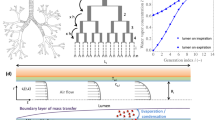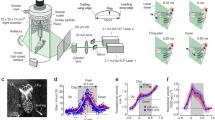Abstract
The respiratory organs of terrestrial insects consist of tracheal tubes with external spiracular valves that control gas exchange. Despite their relatively high metabolic rate, many insects have highly discontinuous patterns of gas exchange, including long periods when the spiracles are fully closed. Two explanations have previously been put forward to explain this behaviour: first, that this pattern serves to reduce respiratory water loss1, and second, that the pattern may have initially evolved in underground insects as a way of dealing with hypoxic or hypercapnic conditions2. Here we propose a third possible explanation based on the idea that oxygen is necessary for oxidative metabolism but also acts as a toxic chemical that can cause oxidative damage of tissues even at relatively low concentrations. At physiologically normal partial pressures of CO2, the rate of CO2 diffusion out of the insect respiratory system is slower than the rate of O2 entry; this leads to a build-up of intratracheal CO2. The spiracles must therefore be opened at intervals to rid the insect of accumulated CO2, a process that exposes the tissues to dangerously high levels of O2. We suggest that the cyclical pattern of open and closed spiracles observed in resting insects is a necessary consequence of the need to rid the respiratory system of accumulated CO2, followed by the need to reduce oxygen toxicity.
This is a preview of subscription content, access via your institution
Access options
Subscribe to this journal
Receive 51 print issues and online access
$199.00 per year
only $3.90 per issue
Buy this article
- Purchase on Springer Link
- Instant access to full article PDF
Prices may be subject to local taxes which are calculated during checkout




Similar content being viewed by others
References
Levy, R. I. & Schneiderman, H. A. Discontinuous respiration in insects. II. The direct measurement and significance of changes in tracheal gas composition during the respiratory cycle of silkworm pupae. J. Insect Physiol. 12, 83–104 (1966)
Lighton, J. R. B. Notes from the underground: toward ultimate hypotheses of cyclic, discontinuous gas-exchange in tracheate arthropods. Am. Zool. 38, 483–491 (1998)
Wigglesworth, V. B. The Principles of Insect Physiology (Methuen, London, 1970)
Krogh, A. Studien ueber tracheenrespiration. II. Ueber gasdiffusion in den tracheen. Pfluegers Arch. 179, 95–112 (1920)
Krogh, A. Studien über die tracheenrespiration. III. Die kombination von mechanischer ventilation mit gasdiffusion nach versuchen an dytiscidenlarven. Pflugers Arch. 179, 113–120 (1920)
Slama, K. A new look at insect respiration. Biol. Bull. 175, 289–300 (1988)
Westneat, M. W. et al. Tracheal respiration in insects visualized with synchrotron x-ray imaging. Science 299, 558–560 (2003)
Slama, K. Active regulation of insect respiration. Ann. Entomol. Soc. Am. 92, 916–929 (1999)
Lighton, J. R. B. Discontinuous gas exchange in insects. Annu. Rev. Entomol. 41, 309–324 (1996)
Hadley, N. F. Ventilatory patterns and respiratory transpiration in adult terrestrial insects. Physiol. Zool. 67, 175–189 (1994)
Chown, S. L. & Holter, P. Discontinuous gas exchange cycles in Aphodius fossor (Scarabaeidae): a test of hypotheses concerning origins and mechanisms. J. Exp. Biol. 203, 397–403 (2000)
Williams, A. E. & Bradley, T. J. The effect of respiratory pattern on water loss in desiccation-resistant Drosophila melanogaster. J. Exp. Biol. 201, 2953–2959 (1998)
Lighton, J. R. B. & Garrigan, D. Ant breathing: testing regulation and mechanism hypotheses with hypoxia. J. Exp. Biol. 198, 1613–1620 (1995)
Bradley, T. J., Brethorst, L., Robinson, S. & Hetz, S. Changes in the rate of CO2 release following feeding in the insect Rhodnius prolixus. Physiol. Biochem. Zool. 76, 302–309 (2002)
Richardson, R. S., Noyszeski, E. A., Kendrick, K. F., Leigh, J. S. & Wagner, P. D. Myoglobin O2 desaturation during exercise: evidence of limited O2 transport. J. Clin. Invest. 96, 1916–1926 (1995)
Jamieson, D. Oxygen toxicity and reactive oxygen metabolites in mammals. Free Radic. Biol. Med. 7, 87–108 (1989)
Fridovich, I. Oxygen is toxic! Bioscience 27, 462–466 (1977)
Sohal, R. S., Agarwal, S. & Orr, W. C. Simultaneous overexpression of copper-and zinc-containing superoxide dismutase and catalase retards age-related oxidative damage and increases metabolic potential in Drosophila melanogaster. J. Biol. Chem. 270, 15671–15674 (1995)
Schwarze, S. R., Weindruch, R. & Aiken, J. M. Oxidative stress and aging reduce Cox 1 RNA and cytochrome oxidase activity in Drosophila. Free Radic. Biol. Med. 25, 740–747 (1998)
Orr, W. C. & Sohal, R. S. Extension of life-span by over-expression of superoxide dismutase and catalase in Drosophila melanogaster. Science 263, 1128–1130 (1994)
Sun, J., Folk, D., Bradley, T. J. & Tower, J. Induced overexpression of mitochondrial Mn-superoxide dismutase extends the life span of adult Drosophila melanogaster without changing metabolic rate. Genetics 161, 661–672 (2002)
Yan, L. J. & Sohal, R. S. Mitochondrial adenine nucleotide translocase is modified oxidatively during aging. Proc. Natl Acad. Sci. USA 94, 11168–11172 (1997)
Lighton, J. R. B. & Fielden, L. J. Gas exchange in wind spiders (Arachnida, Solphugidae). Independent evolution of convergent control strategies in solphugids and insects. J. Insect Physiol. 42, 347–357 (1996)
Fielden, L. J. & Lighton, J. R. B. Effects of water stress and relative humidity on ventilation in the tick Dermacentor andersoni (Acari, Iodidae). Physiol. Zool. 69, 599–617 (1996)
Lighton, J. R. B. & Joos, B. Discontinuous gas exchange in the pseudoscorpion Garypus californicus is regulated by hypoxia, not hypercapnia. Physiol. Biochem. Zool. 75, 345–349 (2002)
Lighton, J. R. B. Discontinuous CO2 emission in a small insect, the formicine ant Camponotus vicinus. J. Exp. Biol. 134, 363–376 (1988)
Weibel, E. R. Symmorphosis and optimization of biological design: introduction and questions. In Principles of Animal Design (Cambridge Univ. Press, Cambridge, 1998)
Weibel, E. R. et al. Design of the oxygen and substrate pathways. 7. Different structural limits for oxygen and substrate supply to muscle mitochondria. J. Exp. Biol. 199, 1699–1709 (1996)
Davis, A. L. V., Chown, S. L. & Scholtz, C. H. Discontinuous gas-exchange cycles in Scarabaeus dung beetles (Coleoptera: Scarabaeidae): Mass-scaling and temperature dependence. Physiol. Biochem. Zool. 72, 555–565 (1999)
Hetz, S. K., Wasserthal, L. T., Hermann, S., Kaden, H. & Oelssner, W. Direct oxygen measurements in the tracheal system of Lepidopterous pupae using miniaturized amperometric sensors. Bioelectrochem. Bioenerg. 33, 165–170 (1994)
Acknowledgements
We thank N. Heisler for comments and for providing equipment. T.J.B. would like to thank N. Heisler for his hospitality during a research visit. This work was supported by an NSF grant to T.J.B.
Author information
Authors and Affiliations
Corresponding author
Ethics declarations
Competing interests
The authors declare that they have no competing financial interests.
Rights and permissions
About this article
Cite this article
Hetz, S., Bradley, T. Insects breathe discontinuously to avoid oxygen toxicity. Nature 433, 516–519 (2005). https://doi.org/10.1038/nature03106
Received:
Accepted:
Issue Date:
DOI: https://doi.org/10.1038/nature03106
This article is cited by
-
Sublethal biochemical, behavioral, and physiological toxicity of extremely low dose of bendiocarb insecticide in Periplaneta americana (Blattodea: Blattidae)
Environmental Science and Pollution Research (2023)
-
Increased fire activity under high atmospheric oxygen concentrations is compatible with the presence of forests
Nature Communications (2022)
-
Ozone reduces lifespan and alters gene expression profiles in Rhyzopertha dominica (Fabricius)
3 Biotech (2022)
-
Field evaluation of hermetic and synthetic pesticide-based technologies in smallholder sorghum grain storage in hot and arid climates
Scientific Reports (2021)
-
Feeding and respiratory gas exchange of Rhipicephalus sanguineus sensu lato (Acari: Ixodidae)
Experimental and Applied Acarology (2019)
Comments
By submitting a comment you agree to abide by our Terms and Community Guidelines. If you find something abusive or that does not comply with our terms or guidelines please flag it as inappropriate.



